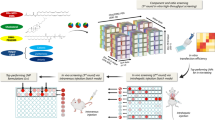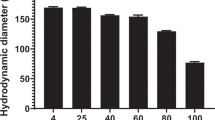Abstract
To achieve hepatocyte-targeted in vivo gene expression, a carrier that controls both the tissue and intracellular distribution of DNA was designed and synthesized. A cationic polymer, poly(L-ornithine) (pOrn), was modified first with galactose, then with a fusigenic peptide (mHA2) to obtain Gal-pOrn-mHA2. When applied with Gal-pOrn-mHA2 to asialoglycoprotein receptor-positive cells, fluorescein-labeled DNA showed a diffuse profile, suggesting the release of DNA from endosomes and/or lysosomes by the carrier. Then the biodistribution and gene expression after intravenous injection of DNA complexes (10 μg DNA per mouse) were examined. After injection of [32P]DNA/Gal-pOrn-mHA2, about 60% of the radioactivity was recovered in the liver, mostly in parenchymal cells. A large amount (81 ng/g tissue) of transgene product (luciferase) was detected in the liver of mice injected with DNA/Gal-pOrn-mHA2, which was 280-fold greater than that obtained with DNA/DOTMA:Chol liposomes (50 μg DNA). Prior administration of galactosylated albumin reduced the gene expression to 1/100, indicating the asialoglycoprotein receptor-mediated gene transfer in liver parenchymal cells, ie hepatocytes. The luciferase activity in hepatocytes contributed more than 95% of the total activity in all the tissues examined. Thus, hepatocyte-targeted in vivo gene expression was achieved by the intravenous injection of DNA complex with the multifunctional gene carrier.
This is a preview of subscription content, access via your institution
Access options
Subscribe to this journal
Receive 12 print issues and online access
$259.00 per year
only $21.58 per issue
Buy this article
- Purchase on Springer Link
- Instant access to full article PDF
Prices may be subject to local taxes which are calculated during checkout







Similar content being viewed by others
References
Anderson WF . Human gene therapy Nature 1998 392: (Suppl.) 25–30
Mahato RI, Takakura Y, Hashida M . Nonviral vectors for in vivo gene delivery: physicochemical and pharmacokinetic considerations Crit Rev Ther Drug Carrier Syst 1997 14: 133–172
Lee RJ, Huang L . Lipidic vector systems for gene transfer Crit Rev Ther Drug Carrier Syst 1997 14: 173–206
Ledley FD . Nonviral gene therapy: the promise of genes as pharmaceutical products Hum Gene Ther 1995 6: 1129–1144
Curiel DT et al. Adenovirus enhancement of transferrin-polylysine-mediated gene delivery Proc Natl Acad Sci USA 1991 88: 8850–8854
Cristiano RJ, Smith LC, Woo SLC . Hepatic gene therapy: adenovirus enhancement of receptor-mediated gene delivery and expression in primary hepatocytes Proc Natl Acad Sci USA 1993 90: 2122–2126
Wu GY et al. Incorporation of adenovirus into a ligand-based DNA carrier system results in retention of the original receptor specificity and enhances targeted gene expression J Biol Chem 1994 269: 11542–11546
Kaneda Y, Iwai K, Uchida T . Increased expression of DNA cointroduced with nuclear protein in adult rat liver Science 1989 243: 375–378
Kato K et al. Expression of hepatitis B virus surface antigen in adult rat liver. Co-introduction of DNA and nuclear protein by a simplified liposome method J Biol Chem 1991 266: 3361–3364
Pinnaduwage P, Schmitt L, Huang L . Use of a quaternary ammonium detergent in liposome mediated DNA transfection of mouse L-cells Biochim Biophys Acta 1989 985: 33–37
Wagner E et al. Influenza virus hemagglutinin HA-2 N-terminal fusigenic peptides augment gene transfer by transferrin-polylysine/DNA complexes: towards a synthetic virus-like gene transfer vehicle Proc Natl Acad Sci USA 1992 89: 7934–7938
Gottschalk S et al. A novel DNA–peptide complex for efficient gene transfer and expression in mammalian cells Gene Therapy 1996 3: 448–457
Plank C et al. The influence of endosome-disruptive peptides on gene transfer using synthetic virus-like gene transfer systems J Biol Chem 1994 269: 12918–12924
Wu GY, Wu CH . Gene therapy by targeting nucleic acids to hepatocytes. In: Arias IM et al (eds). The Liver: Biology and Pathobiology, third edition Raven Press: New York 1994 pp 1537–1556
Wilson JM . Round two for liver gene therapy Nat Genet 1996 12: 232–233
Zhu N et al. Systemic gene expression after intravenous DNA delivery into adult mice Science 1993 261: 209–211
Song YK et al. Characterization of cationic liposome-mediated gene transfer in vivo by intravenous administration Hum Gene Ther 1997 8: 1585–1594
Li S, Huang L . In vivo gene transfer via intravenous administration of cationic lipid-protamine-DNA (LPD) complexes Gene Therapy 1997 4: 891–900
Mahato RI et al. In vivo disposition characteristics of plasmid DNA complexed with cationic liposomes J Drug Targeting 1995 3: 149–157
Osaka G et al. Pharmacokinetics, tissue distribution, and expression efficiency of plasmid 32P-DNA following intravenous administration of DNA/cationic lipid complexes in mice: use of a novel radionuclide approach J Pharm Sci 1996 85: 612–618
Hara T, Tan Y, Huang L . In vivo gene delivery to the liver using reconstituted chylomicron remnants as a novel nonviral vector Proc Natl Acad Sci USA 1997 94: 14547–14552
Budker V et al. Naked DNA delivered intraportally expresses efficiently in hepatocytes Gene Therapy 1996 3: 593–598
Ledley FD et al. Retroviral gene transfer into primary hepatocytes: implications for genetic therapy of liver-specific functions Proc Natl Acad Sci USA 1987 84: 5335–5339
Ferry N et al. Retrovirus-mediated gene transfer into hepatocytes in vivo Proc Natl Acad Sci USA 1991 88: 8377–8381
Grossman M et al. Successful ex vivo gene therapy directed to liver in a patient with familial hypercholesterolaemia Nat Genet 1994 6: 335–341
Wu GY, Wu CH . Receptor-mediated in vitro gene transfections by a soluble DNA carrier complexes J Biol Chem 1986 262: 4429–4432
Wu GY, Wu CH . Receptor-mediated gene delivery and expression in vivo J Biol Chem 1991 263: 14621–14624
Perales JC et al. Biochemical and functional characterization of DNA complexes capable of targeting genes to hepatocytes via the asialoglycoprotein receptor J Biol Chem 1997 272: 7398–7407
Perales JC et al. Gene transfer in vivo: sustained expression and regulation of genes introduced into the liver by receptor-mediated uptake Proc Natl Acad Sci USA 1994 91: 4086–4090
Nishikawa M et al. Targeted delivery of plasmid DNA to hepatocytes in vivo: optimization of the pharmacokinetics of plasmid DNA/galactosylated poly(L-lysine) complexes by controlling their physicochemical properties J Pharmacol Exp Ther 1998 287: 408–415
Hashida M et al. Targeted delivery of plasmid DNA complexed with galactosylated poly(L-lysine) J Control Rel 1998 53: 301–310
Kawabata K, Takakura Y, Hashida M . The fate of plasmid DNA after intravenous injection in mice: involvement of scavenger receptors in its hepatic uptake Pharm Res 1995 12: 825–830
Nishikawa M et al. Galactosylated proteins are recognized by the liver according to the surface density of galactose moieties Am J Physiol 1995 268: G849–G856
Nishikawa M et al. Pharmacokinetics of receptor-mediated hepatic uptake of glycosylated albumin in mice Int J Pharm 1992 85: 75–85
Bennett HS, Luft JH, Hampton JC . Morphological classification of vertebrate blood capillaries Am J Physiol 1959 196: 381–390
Takakura Y et al. Characterization of plasmid DNA binding and uptake by peritoneal macrophages from class A scavenger receptor knockout mice Pharm Res 1999 16: 503–508
Perales JC et al. An evaluation of receptor-mediated gene transfer using synthetic DNA–ligand complexes Eur J Biochem 1994 226: 225–266
Plank C, Zauner W, Wagner E . Application of membrane-active peptides for drug and gene delivery across cellular membranes Adv Drug Delivery Rev 1998 34: 21–35
Liu Y et al. Factors influencing the efficiency of cationic liposome-mediated intravenous gene delivery Nat Biotechnol 1997 15: 167–173
Song YK, Liu F, Liu D . Enhanced gene expression in mouse lung by prolonging the retention time of intravenously injected plasmid DNA Gene Therapy 1998 5: 1531–1537
Löser P et al. Reactivation of the previously silenced cytomegalovirus major immediate–early promoter in the mouse liver: involvement of NFκB J Virol 1998 72: 180–190
Sambrook K, Fritsch EF, Maniatis T . Molecular Cloning: A Laboratory Manual, 2nd edn Cold Spring Harbor Laboratory Press: Plainview: New York 1989
Atherton E et al. The polyamide method of solid phase peptide and oligonucleotide synthesis Bioorg Chem 1979 8: 351–370
Acknowledgements
This work was supported in part by a Grant-in-Aid for Scientific Research from the Ministry of Education, Science, and Culture of Japan.
Author information
Authors and Affiliations
Rights and permissions
About this article
Cite this article
Nishikawa, M., Yamauchi, M., Morimoto, K. et al. Hepatocyte-targeted in vivo gene expression by intravenous injection of plasmid DNA complexed with synthetic multi-functional gene delivery system. Gene Ther 7, 548–555 (2000). https://doi.org/10.1038/sj.gt.3301140
Received:
Accepted:
Published:
Issue Date:
DOI: https://doi.org/10.1038/sj.gt.3301140
Keywords
This article is cited by
-
LINGO-1 siRNA nanoparticles promote central remyelination in ethidium bromide-induced demyelination in rats
Journal of Physiology and Biochemistry (2019)
-
Engineering biodegradable and multifunctional peptide-based polymers for gene delivery
Journal of Biological Engineering (2013)
-
Biodegradable nanoparticles for gene therapy technology
Journal of Nanoparticle Research (2013)
-
Metabolically stabilized long-circulating PEGylated polyacridine peptide polyplexes mediate hydrodynamically stimulated gene expression in liver
Gene Therapy (2011)
-
Synthesis of a polyamidoamine dendron-bearing lipid having sugar moieties and its use for preparation of nonviral gene vectors
Research on Chemical Intermediates (2009)



